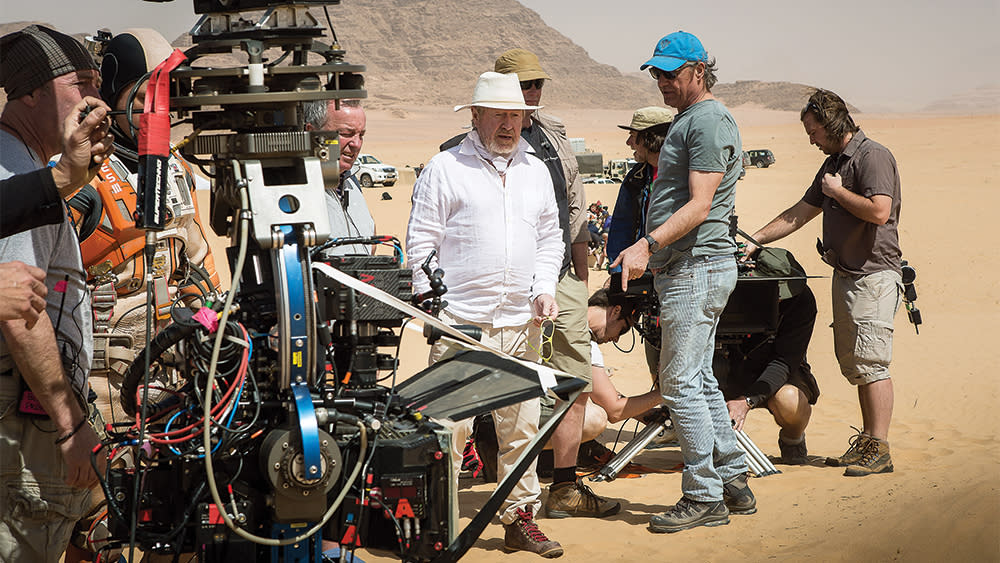Ridley Scott Praises His Out-of-This-World ‘The Martian’ Crew

Ridley Scott likes to storyboard every scene in his movies. He spent seven years in art school, and can draw vividly and quickly, in pencil and then gray felt-tips. When the boards are finished, he’s essentially shot the film on paper, but is quick to point out he’s far from finished with the creative process. “The boards are a starting point,” he explains. “Nothing is locked down; I’m always leaving room for the actors and for the team.” He spoke with Variety about some of the key below-the-line contributors to Fox’s “The Martian,” an awards contender and a box office hit.
Cinematographer: Dariusz Wolski
“Dariusz has a great eye and great taste. He is a great camera operator. I think any cinematographer should operate the camera occasionally; if you don’t, you don’t understand the frame. Dariusz likes the storyboards; he loves to know what we’re doing, because he has to prep it. We always work with multiple cameras. With Dariusz, it’s usually four, but if it’s complicated, it’s five to eight cameras. It’s knowing where to place them. We shot ‘The Martian’ in 72 days. Normally it would be 100 to 110. Part of that is multicamera, part of it is knowing what you’re doing. You can’t walk in every morning and say, ‘Let’s talk about this scene.’ Are you kidding me? You can’t do that.”
Editor: Pietro Scalia
“The important thing for the editor is coverage. That’s why I always have multiple cameras, so I can shorten the scene. Half the time it’s about shortening and refining. Drew Goddard’s script was very well done. But if you have a scene that’s four minutes and you think it’s got to be two minutes, you can’t do that unless you’ve got cuts. Pietro understands the process. He has brilliant instincts.”
“The important thing for the editor is coverage. I have multiple cameras so I can shorten the scene.” |
Ridley Scott |
Production designer: Arthur Max
“The key is to always kick off a creative conversation on what each scene can be. Then Arthur will go away and research it with the digital artists; they’ll come back with a digital representation of the set. That also happened for the spacesuits. They’re tricky; they’re industrial design because they have to breathe. I didn’t want to repeat ‘Alien’ or ‘Prometheus.’ I never want to repeat anything. We also set up 30 GoPro cameras inside the habitat. Those took the form of being a buddy or companion to Mark Watney (Matt Damon). So there was Matt talking to the camera — what I called ship’s log, like Captain Kirk. We wanted to avoid voiceover because it’s tricky. It’s better to have Matt talking to himself. To represent NASA, there was a building on the edge of the Danube, the most modern building in Budapest. I would drive past it and think, ‘We better look at that, because I can’t find NASA.’ It was perfect — a giant space, used for events, with a giant tube roof.”
Vfx: Richard Stammers
“For the ending, we needed a massive sense of space, with Melissa Lewis (Jessica Chastain) going after Watney outside the ship, and Watney losing it. The constant interplay and evacuating all the chambers of the ship was tricky because they’re all on bloody wires; everyone’s got four wires to stop them from pendulum-ing; you can’t have that. The gliding has to be perfect, and you’ve got to be acting while gliding.”
Related stories
Animation Veteran Ford Riley Gives Eco-Spin to Disney Channel's 'Lion Guard'
George Miller Pays Tribute to His 'Mad Max: Fury Road' Below-the-Line Crew
For Veteran Directors, Personal Style Never Compromises Fresh Approaches
Get more from Variety and Variety411: Follow us on Twitter, Facebook, Newsletter
